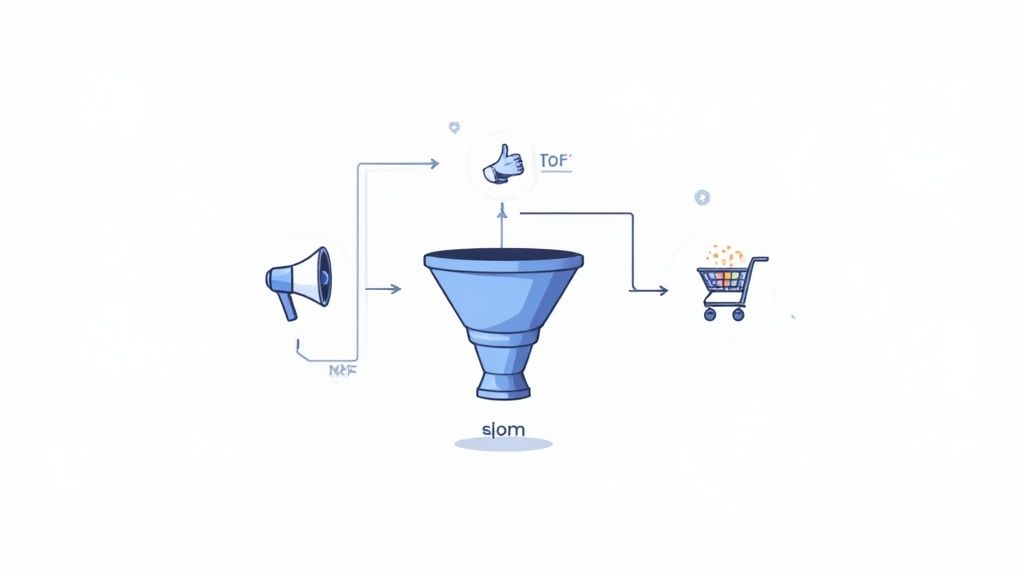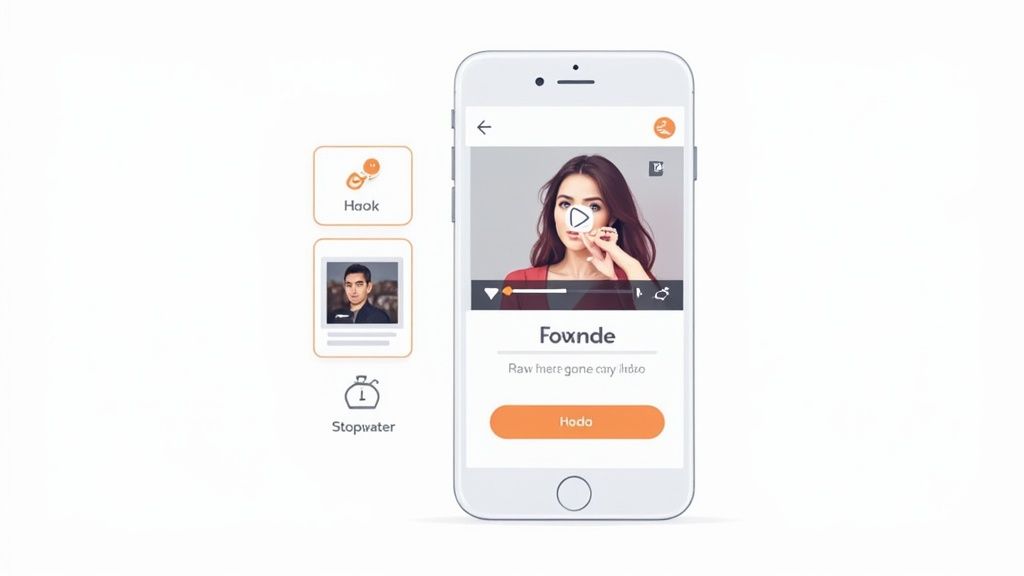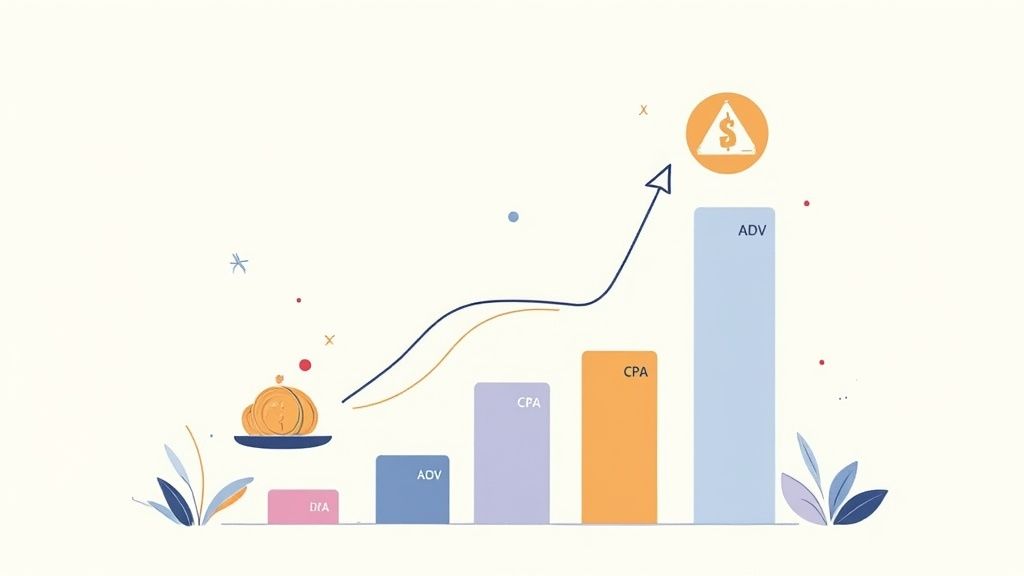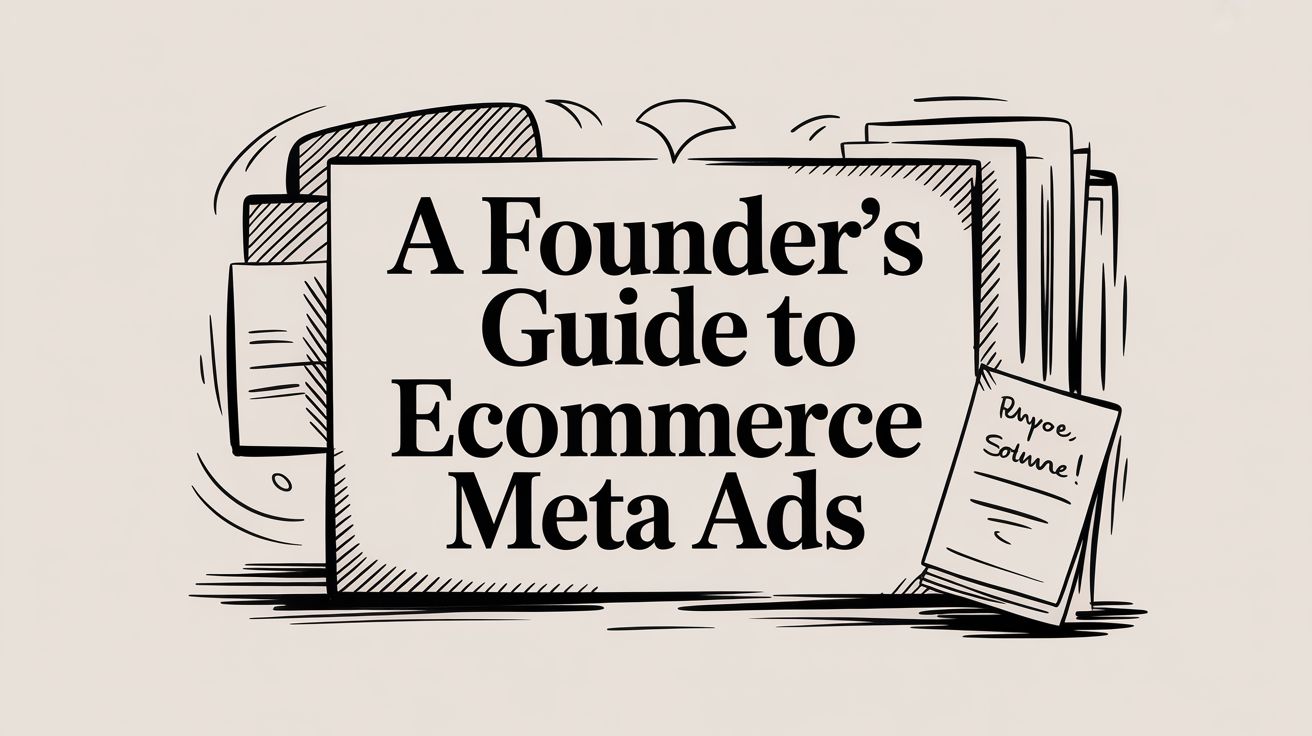If you run a DTC brand, Meta ads aren't optional. Let's get that out of the way. It’s how you reach a massive pool of customers you can't find anywhere else with this level of precision.
Why Meta Ads Still Dominate Ecommerce
Lots of founders got spooked after iOS14. Here's the reality: Meta’s ad engine adapted. It's more powerful now than it's ever been.
The platform's strength is its staggering scale. According to DataReportal, Meta has over 3.24 billion daily active users across its apps. Its potential ad reach jumped by 110 million users in just the last three months of 2023. This isn't just a giant audience. It's an engaged one. And Meta’s algorithm knows how to find the people likely to buy what you’re selling. You can dig into the latest Meta statistics for the full picture.
Before we dive deeper, here's where your ads can show up.
Meta Ads Platform Snapshot
A quick look at the core parts of Meta's ad ecosystem for ecommerce.
Each platform has a different role. They all work together under one powerful ad umbrella.
The New Rules of the Game
Forget what you knew about Meta ads a few years ago. The old playbook of stacking niche interests and manually tweaking bids is dead. The game has changed.
Meta's AI now does the heavy lifting on targeting. This is especially true with tools like Advantage+ Shopping Campaigns. Your job has shifted. You're no longer a granular campaign operator. You're a marketer who feeds the machine high-quality inputs.
What does that mean for you?
- Creative is the new targeting. The algorithm finds your audience. Your ad creative is the most important lever you can pull. Good creative finds good customers.
- Broad targeting works. The system is smart enough to find buyers without you narrowing the audience to a tiny segment. Trust the machine.
- Your data is gold. Customer lists and pixel data are invaluable. They train the AI to find more people exactly like your best customers.
"The platforms are getting smarter, so we don't have to be as granular in our targeting as we once had to be. Let the algorithm do the work for you." - Susan Wenograd, Chief Marketing Officer at Aimclear, in an interview with Search Engine Journal.
Your Unfair Advantage
Many brands are still playing by the old rules. They over-manage campaigns, tinker with tiny audiences, and kill budgets before the algorithm can learn.
By embracing this new reality, you get a huge leg up. You stop wasting time in Ads Manager. You focus on what matters: understanding your customer and creating ads that connect. This modern approach to ecommerce meta ads is how you build a reliable sales engine. The rest of this guide will show you how.
Building Your Ecommerce Sales Funnel on Meta

Let's build your sales machine. Forget the crazy ten-stage diagrams you've seen online. For DTC brands, a winning ad funnel is simple and focused. It turns a stranger into a paying customer.
Think of it like a conversation. First, you introduce yourself. Then you build trust. Finally, you ask for the sale. Each part needs a different approach.
We'll focus on what works for real brands: a straightforward Top, Middle, and Bottom of Funnel strategy.
Top of Funnel (TOF): Making an Introduction
This is your first impression. The goal isn't an instant sale. It’s about finding new people and getting them to stop scrolling.
Your audience is cold. They don't know you. They don't trust you yet. Your only job is to stop their thumb. Use creative that grabs them and introduces your brand or a hero product.
For ecommerce Meta ads at this stage, you’re playing a numbers game. You have to reach a broad audience to see what connects.
- Campaign Objective: Use the Sales objective, optimized for Purchases. Don't overthink it. Meta's AI is good at finding buyers, even in broad, cold audiences. Aim for the sale from day one.
- Audience: Go broad. Seriously. Use lookalike audiences from your best customers. Or just trust Advantage+ audiences and let Meta's algorithm do the work. The days of stacking narrow interests are over.
- Creative: This is everything. Use an attention-grabbing video, raw user-generated content (UGC), or a killer static image. Your creative should instantly show your product's benefit. Educate and entertain, don't just sell.
Middle of Funnel (MOF): Building Trust
Someone engaged with your brand. Maybe they watched a video, clicked to your site, or liked a post. They know who you are. But they're still on the fence.
The point of the MOF is to build credibility and stay on their radar. You need to prove you're a real brand with a product people love.
- Campaign Objective: Stick with the Sales objective. You're retargeting people who've already shown interest. They are a high-value audience for conversion campaigns.
- Audience: Retarget people who've engaged with your ads or social profiles in the last 30-90 days. You can also build audiences from your email list. Or people who visited product pages but didn't add to cart.
- Creative: Social proof is king here. Show customer testimonials. Show press mentions. Show UGC of real people using your product. Your ad copy should answer common questions or handle objections before they even have them.
“Not everyone who visits your site from ads is going to purchase right away and you need to be able to follow up with them.” - Jessica Totillo Coster, Ecommerce Badassery
That follow-up is the middle of the funnel. You earned their attention. Now earn their trust before you ask for their business.
Bottom of Funnel (BOF): Closing the Sale
This is the final step. Your audience is hot. They've been to your website. They've added a product to their cart. Maybe they even started checkout. They are on the edge of buying.
Your only job is to get them across the finish line.
- Campaign Objective: You guessed it—the Sales objective. This is where it's most powerful.
- Audience: Get specific. Target high-intent actions. We're talking about people who abandoned their cart in the last 7-14 days. This is your most valuable audience. Treat them like gold.
- Creative: Be direct. Remind them what they left behind. Use Dynamic Product Ads (DPA) to show them the exact item in their cart. A small nudge like a discount or free shipping can be all it takes. Make it easy for them to say yes.
How to Master Audience Targeting in the AI Era
Let's be direct. Audience targeting for ecommerce ads on Meta has changed completely. If you spend hours stacking niche interests, you’re playing an outdated game.
The old way was about manual control. The new way is about feeding the machine the right signals. Let its AI do the heavy lifting. Winning today means shifting your mindset. Be a smart strategist who guides the algorithm, not a micromanager.
This approach is simpler. It's also far more effective. It frees you to focus on what moves the needle: your creative and your offer.
Trusting Meta's AI with Broad Targeting
The biggest shift you need to make is trusting broad audiences. This feels wrong if you're used to being in control. But Meta’s algorithm is now incredibly good at finding buyers without your help.
When you go broad, you give the algorithm a massive pool to learn from. It quickly finds patterns and pockets of buyers you would have never discovered on your own. This is the principle behind Advantage+ Shopping Campaigns. And it works.
A 2023 McKinsey report found that a quarter of all companies surveyed are already using generative AI in their marketing. This shift to automation is the new standard for profitable scaling. This is also where you can find some of the best AI marketing tools to help with other parts of your workflow.
Using Your Data as Fuel
While going broad is powerful, your own data is your most valuable asset. This isn’t just about first-party data like website visitors anymore. Sharp marketers are also leveraging zero-party data effectively to understand what customers explicitly want.
Your data acts as the "seed" that teaches the algorithm what your best customers look like.
Here are the key data sources to focus on:
- Customer Lists: Upload your list of past purchasers. This is the highest-quality signal you can provide. Meta will use it to find people with similar behaviors.
- Website Visitors: Your Meta Pixel tracks who visits your site, views products, and adds items to their cart. This data is essential for both retargeting and building powerful lookalike audiences.
- Engagement Audiences: People who have liked, commented, or shared your posts are warm leads. They know your brand and are more likely to convert.
The goal isn’t to find every customer yourself. It's to give the AI a clear picture of your ideal customer so it can find thousands more just like them.
Building High-Value Lookalike Audiences
Lookalike Audiences are where your data comes to life. You give Meta a source audience (like your customer list). Its AI builds a new, larger audience of people who share similar traits.
Not all lookalikes are created equal. Here’s a simple framework for creating ones that perform:
- Start with High-Value Sources: Create lookalikes from your best customers. These are people with a high lifetime value or repeat purchase history. A clean list of 1,000+ high-value customers is a perfect start.
- Use Purchase Events: Build a lookalike from people who have triggered the "Purchase" event on your Pixel. This targets users who have already proven they are willing to buy online.
- Keep it Simple: Start with a 1% lookalike. This creates a smaller, more concentrated audience that is most similar to your source. You can expand to 3% or 5% as you scale. But 1% is almost always the most profitable.
Combine broad targeting with high-quality lookalikes. The lookalikes find qualified users. Broad targeting gives the algorithm room to explore. This two-pronged approach is key to modern ecommerce ads on Meta.
The Creative Strategy That Actually Sells Products

Let's get straight to the point. Creative is the new targeting. Meta’s AI handles most of the audience selection. Your ad creative is the single biggest lever you can pull for success.
The algorithm is smart. But it can’t make a bad ad work. Your job is no longer mastering audience settings. It’s creating ads that stop the scroll, build trust, and convince someone to buy.
Your success with ecommerce Meta ads comes down to the quality of your creative. Garbage in, garbage out. Let's break down what works right now.
Your Creative Arsenal: What Works Today
Forget finding one "magic" ad format. A strong creative strategy uses a mix of assets. Each has a specific job. You need a blend of raw authenticity and polished brand storytelling. This connects with different types of buyers.
Here’s what your creative mix should look like:
- User-Generated Content (UGC): This is your bread and butter. Raw, unpolished videos and photos from real customers are powerful. They look native to the feed. They provide instant social proof.
- Polished Studio Shots: High-quality product photos and lifestyle images still have their place. Use these to show product details, communicate brand quality, and for retargeting ads.
- Direct-Response Video: These videos have one goal: to sell. They often feature a clear problem-solution arc. They need a strong hook in the first three seconds and a direct call to action.
The best creative feels like it belongs in a user's feed, not like an ad that interrupts it. Authenticity from UGC builds trust instantly. Polished creative reinforces your brand's quality. A healthy mix of both is what wins.
Crafting Copy That Actually Converts
Your ad copy has one job. Get the right person to take the next step. No fluff. No clever wordplay. Just clear benefits and a direct call to action.
Nobody cares about your product's "features." They care about what it will do for them. Frame everything in terms of the customer's benefit.
- Instead of: "Our moisturizer has hyaluronic acid."
- Try: "Get visibly hydrated, smoother skin in 7 days."
Your copy should be short, punchy, and easy to read on a phone. Lead with the most important benefit. Use simple language. End with a clear instruction like "Shop Now." Need a framework? This guide on UGC ads copy breaks it down perfectly.
Structuring Your Creative Tests
You won't know what works until you test it. But "testing" isn't throwing random ads at a wall. You need a structured approach.
A simple, effective testing framework looks like this:
- Start with 3-5 Different Concepts: Don't just test variations of the same ad. Test different angles. For a skincare brand, one ad could focus on ingredients, another on a testimonial, and a third on a before-and-after.
- Use Dynamic Creative: Let Meta do the initial testing. Upload multiple images or videos, headlines, and text into one ad. The algorithm will find the best-performing combinations.
- Focus on Key Metrics: Don't just look at ROAS. Pay attention to the leading indicators that tell you why an ad is working (or not).
To understand creative performance, look beyond basic metrics. For video ads, two numbers are critical. They diagnose what’s happening in those crucial first few seconds.
- Hook Rate: The percentage of people who watch at least the first 3 seconds. A low hook rate means your opening is failing.
- Hold Rate: The percentage of people who watch up to the 15-second mark. A high hook rate but a low hold rate means the intro is good, but the rest of the ad isn’t keeping their attention.
Analyze these metrics. You can quickly find your winning creative elements and iterate. This systematic approach is how you build a reliable system for producing ads that sell.
How to Budget and Scale Your Meta Ads Profitably

How much should you spend? When do you scale? These are the questions that keep founders up at night. Get your budget right, and you grow profitably. Get it wrong, and you're just burning cash.
Let's get straight to it. There’s no magic number for a starting budget. The goal is to give Meta’s algorithm enough data to learn. A solid rule of thumb is to set your daily budget at 1x your target Cost Per Acquisition (CPA).
If you sell a $100 product and your goal is to acquire customers for $40, start with a $40 daily budget per ad set. This gives the system enough runway to find at least one customer per day. That's the bare minimum signal it needs to start optimizing.
ABO vs. CBO: When to Use Each
You have two ways to manage your budget: Ad Set Budget Optimization (ABO) and Campaign Budget Optimization (CBO). They each have a specific job.
- Ad Set Budget Optimization (ABO): You set a specific budget for each ad set. This gives you precise control over spend for a specific audience or creative test. Think of it as manual control.
- Campaign Budget Optimization (CBO): You set one budget at the campaign level. Meta’s algorithm then shifts money to the best-performing ad sets in real time. This is autopilot.
Use ABO when you’re testing. If you want to find out which of three new creatives works best, ABO ensures each gets a fair shot. It stops the algorithm from favoring one ad set before it has enough data.
Use CBO when you’re scaling. Once you’ve identified your winning audiences and creatives from ABO tests, group them into a single CBO campaign. This lets the algorithm push budget to your top performers and maximize results automatically.
Clear Signals to Scale Your Ad Spend
Scaling isn't about gut feelings. It's about data-backed signals. Pushing the budget too early is one of the fastest ways to kill profitability.
Scaling profitably is less about speed and more about discipline. You scale when the numbers tell you to, not when you feel impatient. Wait for stable performance, then add fuel to the fire—not before.
Look for these green lights before you increase your budget:
- Consistent Profitability: Your campaign has been hitting or beating your target CPA or ROAS for at least 3-5 consecutive days. One good day is a fluke. A consistent trend is a signal.
- Stable Metrics: Your core metrics like Cost Per Click (CPC) and Click-Through Rate (CTR) are holding steady. If they're all over the place, the campaign isn't stable enough for more budget.
- Sufficient Conversion Volume: The campaign is generating a healthy number of conversions. Trying to scale a campaign with only a handful of sales is a gamble.
When you see these signals, scale your budget slowly. A 20% increase every 2-3 days is a safe bet. This gradual ramp-up lets the algorithm adjust without getting shocked back into a volatile learning phase. This is a cornerstone of effective marketing spend optimization for any ecommerce brand.
Meta's ad revenue is projected to grow to over $174 billion in 2025, according to Statista. The opportunity is massive if you know how to play the game.
For a little help building those winning ads, check out our Meta Ads Pack.
How to Fix Common Ecommerce Ad Problems

Sooner or later, your best ecommerce meta ads will hit a wall. Costs creep up. Conversions crater. That winning ad suddenly feels like dead weight.
This isn't a sign you failed. It's just part of the game.
The worst thing you can do is panic and kill a campaign. You need a playbook for diagnosing the real problem and fixing it. The issue is almost always your creative, your audience, or your landing page.
This is your field guide for figuring out what’s broken.
High Costs but No Clicks (Low CTR)
If you're burning through your budget but nobody is clicking, your ad creative is failing. It’s not stopping the scroll. This is a top-of-funnel problem. Your ad isn't grabbing attention.
Your first move is to diagnose the creative. Don't blame the audience yet.
- Is your hook weak? The first three seconds of a video or the main image have to land a punch. Test a new opening or a bolder visual.
- Is the message unclear? If someone can't immediately understand what you're selling, they won't click. Make your value prop painfully obvious in the first lines of copy.
- Does your ad look like an ad? People ignore anything that feels too polished. Try swapping in some raw user-generated content (UGC) that feels native to their feed.
Clicks but No Sales (Low Conversion Rate)
This is one of the most frustrating problems. People are interested enough to click. But when they land on your site, the magic is gone. The problem isn't your ad. It's the post-click experience.
You have to walk the path from your ad to the checkout. Find the friction.
A high click-through rate with a low conversion rate is a blaring signal of a disconnect. Your ad wrote a check that your landing page couldn't cash. Somewhere between the promise of the ad and the reality of your site, the trust broke down.
Before you touch your campaign, look at your website. Is the page loading slowly? Is the offer different from what you promised in the ad? Does your mobile checkout have ten steps? A quick audit of your product page usually reveals where you’re losing people.
Ad Performance Suddenly Drops
When a winning ad suddenly dies, the most common culprit is creative fatigue. Your audience has seen it too many times. Now it's just background noise.
According to a survey by Consumer Acquisition, 56% of advertisers say creative fatigue is their biggest challenge. Staying on top of this requires a constant refresh of new ideas and angles.
When things go sideways, you need a quick way to diagnose the problem.
This checklist is your first line of defense. Use it to quickly pinpoint the real issue.
Ad Performance Diagnostic Checklist
Fixing broken campaigns isn't guesswork. It's a skill. Systematically work through the issues—creative, landing page, or audience. You can stop wasting money and start making fixes that get your ads firing again.
FAQ: Your Ecommerce Meta Ads Questions
We get it. Running Meta ads for your brand opens up a million questions. Here are some straight, no-BS answers to the questions we hear most often from founders.
How much should I spend on Meta ads when starting out?
There is no magic number. Your goal is to give Meta's algorithm enough data to learn. A good rule is to budget enough to get 50 conversions per ad set per week. This is the threshold Meta recommends for its learning phase to be completed efficiently.
So, if your target cost-per-acquisition (CPA) is $25, you should aim for a weekly budget of $1,250 per ad set (50 x $25). A daily budget of at least $25-$50 is a practical start. It's less about the dollar amount and more about feeding the machine enough conversion data.
How long does it take for Meta ads to become profitable?
Brace for a learning phase. A new campaign needs about 3-7 days to find its footing. During this time, the algorithm is figuring out who your best customers are.
True profitability depends on your creative, offer, and audience. Some ad sets find their groove in 24 hours. Others might need a full week of testing. The goal in that first week isn't instant profit. It's about gathering data to find the winning combinations you can scale later.
Should I use Advantage+ Shopping Campaigns?
For almost every ecommerce brand, the answer is yes. Advantage+ Shopping Campaigns (ASC) are very good at finding new customers. They roll your prospecting and retargeting into a single, automated campaign.
"Lounge Member B just set up her first Advantage+ campaign, the kind where you do almost nothing as the advertiser and let the algorithm do all the work... it’s gangbusters and the most profitable ad she’s ever had." - Jessica Totillo Coster, Ecommerce Badassery
Think of ASC as the foundation of your Meta strategy. Set up a dedicated, "always-on" campaign and let Meta's AI do the work. You can still run separate, manual campaigns for specific launches. But ASC should be your workhorse.
What’s a good return on ad spend for ecommerce?
There is no universal "good" Return on Ad Spend (ROAS). It's completely tied to your product's profit margins.
A brand with 80% margins can be very profitable at a 2.5x ROAS. A brand with 30% margins might need a 4x ROAS just to break even.
Stop chasing vanity benchmarks. Figure out your break-even ROAS. It's simple:
Break-Even ROAS = 1 / Your Profit Margin
If your profit margin is 40% (0.40), your break-even ROAS is 1 ÷ 0.40, which is 2.5x. This is the only number that matters. Your goal is to stay above that number. Anything more is profit.
Running a brand is chaotic enough. Needle gives you an AI marketing agency in one tab, turning your data into campaigns that actually work. We handle the strategy, creative, and execution so you can focus on building your business.

